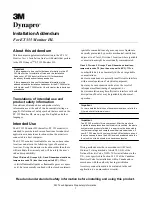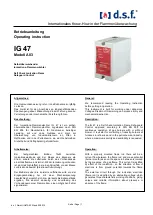
FUNCTION OF THE SPEED
SENSE RELAY
Certain types of feeds, tooling, and threading devices
must be started at slow speed. However, once these
parts are in motion, their speed may be increased for
more efficient operation. In order that the press may be
started at speeds commensurate with the tolerable
starting rate of these auxiliary devices, preset controls
may be built-in to automatically reduce speed of the
drive whenever the press is stopped.
The speed sensitive relay is used as a checking device
to make certain speed has been reduced adequately
prior to engagement of the press clutch. If motor output
speed is too fast for an acceptable starting rate, the
relay will open contacts in the control run circuit to pre-
vent press clutch engagement.
The speed range through which the speed sensitive
relay is energized can be changed. Adjustment proce-
dures are explained below.
CHASSIS AND PANEL
MOUNTED COMPONENTS
INDICATOR LIGHTS
A neon indicator light, labeled “POWER,” is connected
across the output terminals of the D.C. power supply
rectifier bridge. Failure of the lamp to glow would indi-
cate failure of power supply bridge or lack of A.C. input
power.
Additional neon indicator lamps (CLUTCH and
BRAKE) are connected across the coupling and brake
coils to serve as an indication of coil excitation. To
accurately measure the amount or presence of a small
excitation voltage on the coupling or brake, a D.C. volt-
meter should be used since a rather large “threshold”
voltage is needed to light neon indicators. This excita-
tion voltage can be signal checked between terminals
3 (F2/C2) and 5 (F1/C1 signal) or terminals 4 (B2 sig-
nal) and 6 (C1 signal) for the coupling (clutch) or brake
respectively.
POWER OFF/ON
A power switch is mounted on the face of the SCRB-68
Eddy Current Coupling Control and provides a conve-
nient means of disconnecting power from the control
should the need occur.
CONTROL TRANSFORMER
The voltage from the control transformer is dependent
on what the voltage of the motor coils are rated. In
most cases the motor coils are rated at 90 volts so an
isolated 100 volt secondary transformer winding is nec-
essary to supply A.C. power to the control. If the motor
coils were rated at 115 volts then a 125 volts secondary
transformer winding would be required. This winding is
usually auxiliary to the main control transformer. Appli-
cations with an eddy current brake require this winding
to have a center tap. This center tap is grounded and
also connected to terminal 7.
FUSES
The supply voltage must be fused in all applications of
the SCRB-68 Eddy Current Coupling Control.
— 8 —
Figure 5. SCRB-52/58 Coupling control.
MINSTER
®
Summary of Contents for SCRB-68
Page 21: ...ADDITIONAL COMMENTS 20 ...
Page 22: ......










































